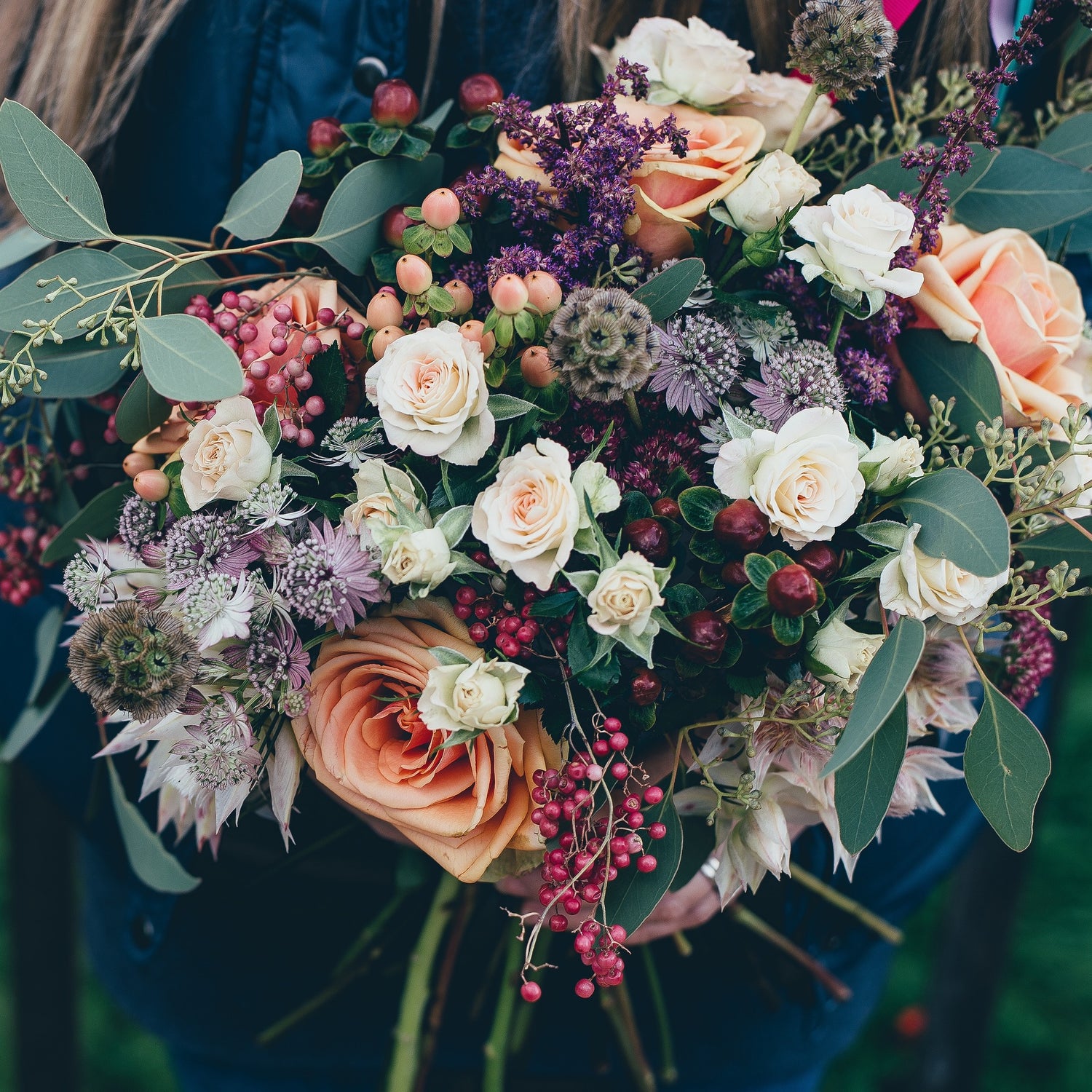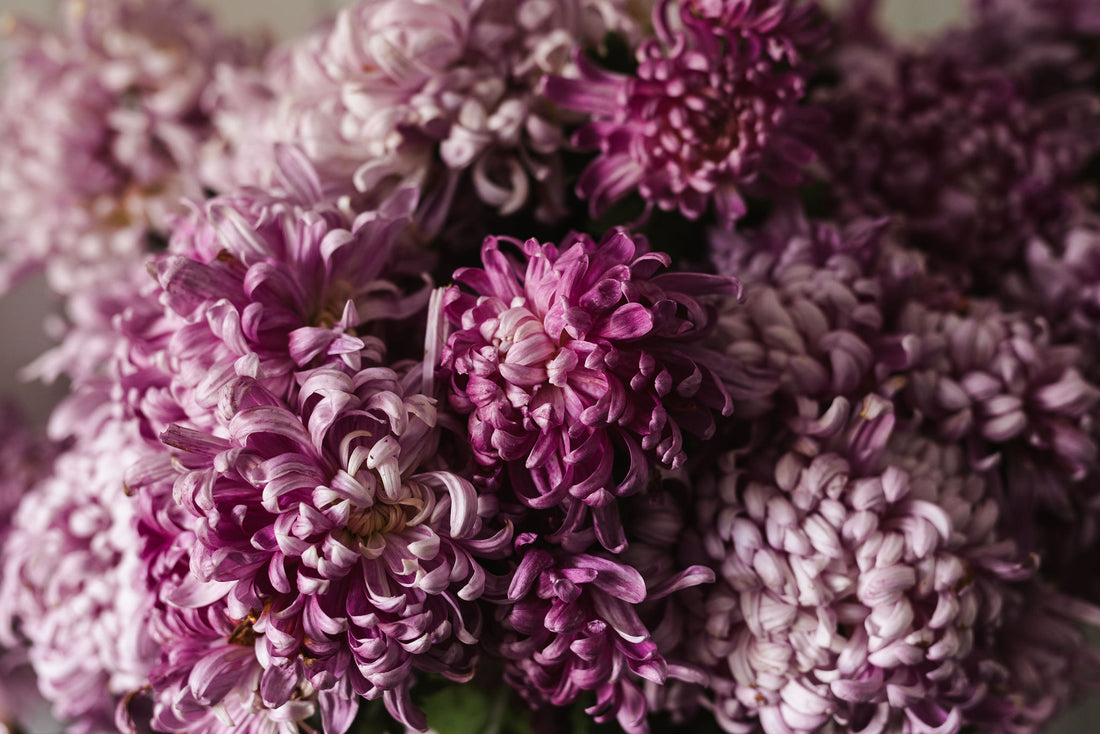|
Buy Me |
Plant Me |
I Flower |
Cut Me |
|
Purchase rooted cuttings in spring (pre-order in autumn and winter). Ignore the varieties sold by big box garden centres or DIY stores as these plants are unlikely to be heirloom varieties. |
Grow rooted cuttings in 8 L pots or plant in the ground. Pinch back in late spring and take time to disbud in summer. Add slow-release fertilizer when you feed your rose bushes. |
In the shorter days from mid-autumn. In many places this is just as the dahlias are finishing giving quality flowers, and just in time for Mother’s Day (AU and USA). |
Cut when the flower is almost fully open. The vase life is superb, lasting two weeks or more. Trying drying your excess stems - we've found our mustard small flowered button varieties dry really well. |

1. Choose Heirloom Chrysanthemums.
Most of us are familiar with the sturdy, softball-sized, ‘disbud mums’ and sprays of daisy-shaped chrysanthemum flowers (mums). This small subset of the large Chrysanthemum family is grown in a restricted range of colours and shapes. Commercial growers produce many hundreds of thousands of stems year-round in greenhouses in warm climates before air freighting them around the world.
However, in private gardens we can cultivate something rather more special. Heirloom varieties come in a wider variety of colours, shapes and sizes, with evocative names like brush and thistle, spoon, irregular incurve, pompon, quill, spider, anemone, and reflex. They produce flowers from 2.5 to 20 cm (1 to 8 inches) in diameter, in a rich spread of colours including coral pink, metallic purple, bronze, burgundy, orange, red, apricot, and yellow.
These elegant flowers are much tougher than they look being drought and heat tolerant, gracefully replacing dahlias as autumn progresses.
2. Take new cuttings every year.
While interest in Heirloom mums is growing, this revival is still in its early stages and plants are not always easy to find. Heirlooms are generally sold as rooted cuttings and sent out in spring with pre-orders taken during autumn and winter. However, like the most sought-after dahlia tubers, demand outstrips supply. So be sure to subscribe to as many mailing lists as possible and get in tout de suite to order the best shades and shapes.
Although a perennial plant, Heirloom Chrysanthemums are more vigorous and less likely to succumb to disease when grown each year from cuttings. Once you have established your first plants, it’s an easy matter to take cuttings and increase numbers each year.
Dig up Chrysanthemum plants when they have finished flowering and developed vigorous new basal shoots. Snip off these shoots and plant into little pots to take root and establish under cover over winter. Be sure to label clearly.
Cuttings can also be taken from the stems. Remove the lower leaves and plant the cutting with just the top pair of leaves above the soil’s surface. Place in a humid environment until roots appear. The old plant is composted, the new rooted cuttings planted out the following spring when the risk of frost has passed.

3. Learn the art of pinching out and disbudding.
Many Chrysanthemums are big plants and can topple over in strong winds if not staked and tied as they grow over summer. ‘Pinch out’ the stem above a set of leaves for a bushier plant with a lower centre of gravity and more usable flower stems. Repeat this several times until mid-summer.
Pinching out will give more flower stems. Each stem will ultimately form many flower buds. To achieve large, impressive focal flowers you will need to ‘edit’ these buds. Left alone, each stem will produce a tightly packed spray of small flowers.
By removing some of the flower buds (in a process called ‘disbudding’) the remaining will grow into larger flowers. We play around with disbudding, so we have some stems with sprays of small flowers, others with a few medium flowers and some with a single, very large flower.
Tip: The ‘pinched out’ stems can be planted in pots as cuttings to take root.

At the start of the season, rather than planting rooted Chrysanthemum cuttings in the ground, many experienced growers replant these cuttings into bigger containers (around 8 ltr). Once the risk of frost has passed, these pots and plants are sunk into the ground. This ensures the Chrysanthemum’s roots (and willingness to spread) is contained and makes it easy to lift the plant and pot out of the ground at the end of the season to take cuttings.
Chrysanthemums are grouped into early and late flowering varieties. Although they are hardy, in places where early autumn frosts are common, the late flowering types will not perform well unless given some protection against the cold. If grown in pots these late flowering types can be lifted out of the ground and moved to a frost-free place away from the wind, perhaps a covered veranda or terrace.
For growers in warm climates where autumn weather is not too stormy (damaging to large flower heads), Chrysanthemums can be grown directly in the ground. You will need to watch for runners and provide sturdy support, but watering will be easier and less time-consuming.
Tip: If you grow Chrysanthemums in pots sunk into the ground, keep an eye on watering, especially through the warm summer months.



